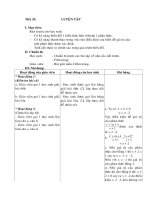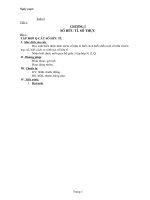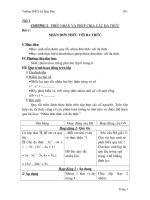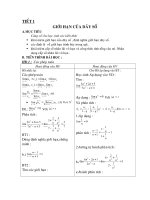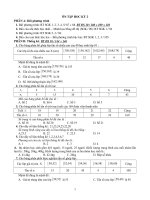Đại số tiểu học (Alg ebra)
Bạn đang xem bản rút gọn của tài liệu. Xem và tải ngay bản đầy đủ của tài liệu tại đây (6.47 MB, 170 trang )
Introduction to Digital
Logic with Laboratory
Exercises
This book is licensed under a Creative Commons Attribution 3.0
License
Introduction to
Digital Logic
with Laboratory
Exercises
James Feher
Copyright © 2009 James Feher
Editor-In-Chief: James Feher
Associate Editor: Marisa
Drexel
Proofreaders: Jackie Sharman, Rachel Pugliese
For any questions about this text, please email:
The Global Text Project is funded by the Jacobs Foundation, Zurich, Switzerland
Introduction to Digital Logic with Laboratory
Exercises
2
A Global
Text
This book is licensed under a Creative Commons Attribution 3.0 License
3
This book is licensed under a Creative Commons Attribution 3.0
License
Table of Contents
Introduction to Digital Logic with Laboratory
Exercises
4
A Global
Text
Preface.................................................................................................................................... 7
0. Introduction.......................................................................................................9
1. The transistor and inverter..............................................................................10
The transistor ....................................................................................................................... 10
The breadboard .................................................................................................................... 11
The inverter .......................................................................................................................... 12
2. Logic gates.......................................................................................................14
History of logic chips ............................................................................................................ 14
Logic symbols ....................................................................................................................... 15
Logical functions ................................................................................................................... 16
3. Logic simplification..........................................................................................19
De Morgan's laws ................................................................................................................. 19
Karnaugh maps .................................................................................................................... 20
Circuit design, construction and debugging ..........................................................................24
4. More logic simplification..................................................................................27
Additional K-map groupings .................................................................................................. 27
Input placement on K-map .................................................................................................... 29
Don't care conditions ............................................................................................................ 29
5. Multiplexer.......................................................................................................32
Background on the “mux” .................................................................................................... 32
Using a multiplexer to implement logical functions ..............................................................32
6. Timers and clocks............................................................................................37
Timing in digital circuits........................................................................................................ 37
555 timer.............................................................................................................................. 37
Timers................................................................................................................................... 37
Clocks.................................................................................................................................... 38
Timing diagrams.................................................................................................................... 39
7.Memory............................................................................................................44
Memory................................................................................................................................. 44
SR latch................................................................................................................................. 44
Flip-flops................................................................................................................................ 45
8. State machines................................................................................................49
What is a state machine?...................................................................................................... 49
State transition diagrams...................................................................................................... 50
State machine design ........................................................................................................... 51
Debounced switches............................................................................................................. 55
9. More state machines........................................................................................57
How many bits of memory does a state machine need?.......................................................57
What are unused states?....................................................................................................... 57
10........................................................................................................What's next?
64
Appendix A: Chip pinouts....................................................................................65
Appendix B: Resistors and capacitors.................................................................69
Resistors................................................................................................................................ 69
Capacitors............................................................................................................................. 70
Appendix C: Lab notebook ...................................................................................71
5
This book is licensed under a Creative Commons Attribution 3.0
License algebra...............................................................................73
Appendix D: Boolean
Appendix E: Equipment list..................................................................................74
Digital trainer......................................................................................................................... 74
7400 series families............................................................................................................... 75
Appendix F: Solutions...........................................................................................76
Chapter 1 review exercises ................................................................................................... 76
Chapter 2 review exercises ................................................................................................... 78
Chapter 3 review exercises ................................................................................................... 81
Chapter 4 review exercises.................................................................................................... 87
Chapter 5 review exercises.................................................................................................... 90
Chapter 6 review exercises.................................................................................................... 95
Chapter 7 review exercises.................................................................................................... 98
Chapter 8 review exercises .................................................................................................. 101
Chapter 9 review exercises .................................................................................................. 104
Index .................................................................................................................105
Introduction to Digital Logic with Laboratory
Exercises
6
A Global
Text
Index of Tables
Table 1: NAND table .............................................................................................15
Table 2: NOR table ...............................................................................................15
Table 3: AB + BC ..................................................................................................16
Table 4: XOR table ...............................................................................................17
Table 5: 4 input K-map ........................................................................................20
Table 6: 2 input K-map ........................................................................................20
Table 7: 3 input K-map ........................................................................................20
Table 8: f(A,B,C) ...................................................................................................21
Table 9: g(A,B,C,D) ..............................................................................................22
Table 10: h(A,B,C,D) ............................................................................................23
Table 11: h(w,x,y,z) .............................................................................................23
Table 12: Step 3 ..................................................................................................23
Table 13: Step 2 ..................................................................................................23
Table 14: Step 5 ..................................................................................................23
Table 15: g(a,b,c) ................................................................................................33
Table 16: g(a,b,c) ................................................................................................33
Table 17: h(a,b,c,d) .............................................................................................34
Table 18: h(a,b,c,d) .............................................................................................34
Table 19: NOR SR latch .......................................................................................44
Table 20: NAND SR latch .....................................................................................44
Table 21: JK flip-flop .............................................................................................45
Table 22: T flip-flop ..............................................................................................45
Table 23: D flip-flop .............................................................................................45
Table 24: Truth table ............................................................................................51
Table 25: Counter truth table ..............................................................................52
Table 26: Q1N(X,Q1,Q0) .......................................................................................53
Table 27: Q0N(X,Q1,Q0) .......................................................................................53
Table 28: Q1N(X,Q1,Q0) = Q1N = x' Q1'Q0' + XQ1'Q0 ........................................58
Table 29: Q0N(X,Q1,Q0) = XQ1'Q0' + X'Q1Q0' .....................................................58
Table 30: Q1N(X,Q1,Q0) = XQ1'Q0' + x'Q0 ..........................................................58
Table 31: Q0N(X,Q1,Q0) = XQ1'Q0' + X'Q1 ..........................................................58
Table 32: Truth table for 5 state machine ...........................................................60
Table 33: Q2N .....................................................................................................60
Table 34: Q1N .....................................................................................................60
Table 35: Q0N ......................................................................................................61
Table 36: Color Codes..........................................................................................69
7
This book is licensed under a Creative Commons Attribution 3.0
License
About the author and reviewers
Author: James Feher
Jim currently teaches computer science at McKendree University in Lebanon, Illinois. He is a huge
open source software proponent. His research focuses on the use of open source software in
theareas of hardware, programming and networking. His hobbies include triathlon, hiking, camping
and the use of alternative energy. He lives with his wife and three kids in St. Louis, MIssouri where he
built and continues to perfect a solar hot water heating system for his home.
Reviewer: Kumud Bhandari
Kumud graduated from McKendree University with degrees in computer science and mathematics.
He has worked at internships at the University of Texas and the Massachusetts Institute of
Technology. He currently isemployed as a researcher with Argonne National Laboratory.
Reviewer: Andrew Van Camp
Professor Van Camp is a retired electronics professor. In addition, he has extensive experience
working and consulting in industry. He currently resides in central Missouri where he continues his
consulting for industry.
Introduction to Digital Logic with Laboratory
Exercises
6
A Global
Text
This book is licensed under a Creative Commons Attribution 3.0
License
Preface
This lab manual provides an introduction to digital logic, starting with simple gates and building
up to state machines. Students should have a solid understanding of algebra as well as a
rudimentary understanding of basic electricity including voltage, current, resistance, capacitance,
inductance and how they relate to direct current circuits. Labs will be built utilizing the following
hardware:
• breadboards with associated items required such as wire, wire strippers and cutters
• some basic discrete components such as transistors, resistors and capacitors
• basic 7400 series logic chips
• 555 timer
Discrete components will be included only when necessary, with most of the labs using the
standard 7400 series logic chips. These items are commonly available and can be obtained relatively
inexpensively. Labs will include learning objectives, relevant theory, review problems, and suggested
procedure. In addition to the labs, several appendices of background material are provided.
Format for each chapter
Each chapter is a combination of theory followed by review exercises to be completed as
traditional homework assignments. Full solutions to all of the review exercises are available in the
last appendix. Procedures for labs then follow that allow the student to implement the concepts in a
hands on manner. The materials required for the labs were selected due to their ready availability at
modest cost. While students would gain from just reading and completing the review exercises, it is
recommended that the procedures be completed as well. In addition to providing another means
reenforcing the material, it helps to develop real world debugging and design skills.
This manual concentrates on the basic building blocks of digital electronics: logic gates and
memory. It focuses on these items from the ground up. The reader will first see how logic gates can
be constructed from transistors and then how digital logic functions are constructed using those
gates. The concept of memory is then introduced through the construction of an SR latch and then a
D flip-flop. A clock is created to be used in a basic state machine design that aims to combine logic
circuits with memory.
Target audience
This text will be geared toward computer science students; however it would be appropriate for
any students who have the necessary background in algebra and elementary DC electronics.
Computer science students learn skills in analysis, design and debugging. These skills are also used
in the virtual world of programming, where no physical devices are ever involved. By requiring the
assembly and demonstration of actual circuits, students will not only learn about digital logic, but
about the intricacies and difficulties that arise when physically implementing their designs as well.
Global Text Project
Introduction to Digital Logic with Laboratory
Exercises
7
A Global
Text
This book is licensed under a Creative Commons Attribution 3.0
Education is the
most powerful weapon you can use to change the world - Nelson
License
Mandela
The goal of this text is to allow more students to gain access to this material by providing it in the
Creative Commons as well as specifying inexpensive materials to be used in the labs. For this reason
the author chose to
Introduction to Digital Logic with Laboratory
Exercises
8
A Global
Text
Preface
This book is licensed under a Creative Commons Attribution 3.0
License
work with the Global Text project to develop this text. The Global Text Project will create open content
electronic textbooks that will be freely available from a website. Distribution will also be possible via
paper, CD, or DVD. The goal of the Global Text Project initially is to focus on content development
and Web distribution, and work with relevant authorities to facilitate dissemination by other means
when bandwidth is unavailable or inadequate. The goal is to make textbooks available to the many
who cannot afford them.
Acknowledgments
A work such as this would not be possible without the help of many. First, I would like to thank the
Global Text Project for their vision of providing electronic textbooks for free to everyone. Marisa
Drexel, Associate Editor at the Global Text Project provided countless suggestions and helpful hints
for the document and for the creation of the document using OpenOffice. Andrew Van Camp II,
retired professor of electronics provided excellent suggestions for technical review of the content.
Kumud Bhandari, currently a research aide at Argonne National Laboratory, provided also provided
technical review of the material. My students Evan VanScoyk, Samantha Barnes, and Ben York all
provided helpful corrections and review as well as countless diagrams found in the document. I
would like tp thank all of the countless open-source developers who produced such fine software as
GNU/Linux, OpenOffice, the Gimp, and Dia which were all used to create this document. I am grateful
to McKendree University for providing support in the form of a sabbatical to allow me to complete
this work. And I certainly wish to thank Sandy who provided excellent review suggestions, support
and an extremely patient ear when I ran into trouble trying to incorporate a new feature from
OpenOffice or attempted edit a particularly tricky graphic.
Introduction to Digital Logic with Laboratory
Exercises
9
A Global
Text
8
This book is licensed under a Creative Commons Attribution 3.0
License
0. Introduction
It is nearly impossible to find a part of society that has not been touched by digital electronics
Obvious applications such as computers, televisions, digital video reorders and countless other
consumer electronics would not be possible without them. The Internet is run on a system of
computers and routing equipment built with digital electronics. Yet even outside of some of these
obvious applications we find that our cars and utilitarian home appliances such as microwaves,
washers, dryers, coffee makers and even refrigerators are all increasingly being designed with digital
electronic controls. You likely carry some sort of device designed with them with you nearly all your
waking hours whether it is a watch, cell phone, MP3 player or PDA. Indeed, digital electronics provide
the foundation upon which we build the infrastructure of modern society.
You no doubt have heard stories about some of the first computers. Machines built with
mechanical relays and vacuum tubes that filled entire rooms. In the 1940S John Bardeen, Walter
Brattain and William Shockley developed the first transistor; it allowed computers to be built
cheaper, smaller and more reliable than ever before. The integrated circuit, a single package
with several transistors along with other circuit components, was developed in the late 1950s by
Jack Kilby at Texas Instruments. This helped to further advance the digital revolution. Advances
then became so common that in the 1960S Gordon Moore, a founder of Intel, proposed his famous
law stating that the capacity of computers we use would double every two years. This observation
has held up since then, even being amended to a doubling every eighteen months.
The quad core microprocessors of today contain millions of components, but the basic building
blocks are digital logic functions combined with memory. Despite the fact that many of these
devices are tremendously complex and require vast amounts of engineering in their design, they all
share the ubiquitous bit as their fundamental unit of data. In essence it all starts with TRUE and
FALSE or 0 and 1. And so the next chapter starts with the simplest of logic devices, the inverter,
built with a single transistor. You then continue your journey into the world of digital electronics by
examining the NAND and NOR gates. Remember, the digital revolution would not be possible
without these simple devices.
Introduction to Digital Logic with Laboratory
Exercises
9
A Global
Text
This book is licensed under a Creative Commons Attribution 3.0
License
1. The transistor
and inverter
Learning objectives
• Use the digital trainer and breadboard.
• Assemble a circuit.
• Build a logic circuit with discrete components.
The transistor
A transistor is a three-terminal device that can be used as an amplifier or as a switch. When the
transistor is used as an amplifier, it is working in analog mode. When it is being used as an electronic
switch, it is functioning in digital mode. The transistor will only be used in digital mode in these labs,
which means the transistor will either be on or off. The terms ground, low, zero, zero volts, open
switch, and dark lamp are all equivalent to the boolean value false. Likewise five volts, high, one,
closed switch, and
lit
lamp
(LED),
are
equivalent
to
the
boolean value true. We will use false (F or 0)
and true (T or 1) when speaking of the logical
states
in
contain
this
manual.
millions
Modern computers
of transistors
combined
together in digital mode to create advanced
circuits.
Transistors are three pin devices that are
similar to valves for controlling electricity. The
amount of current that can flow between the
collector and emitter is a function of the current
flowing through the base of the transistor. If no
current is flowing through the base of
t h e
transistor, no current will flow through the
collector
and
emitter.
With
the
transistor
operating in digital mode, it will be configured
to carry the maximum (if on) or minimum (if
off) amount of
Introduction to Digital Logic with Laboratory
Exercises
1
0
A Global
Text
This book is licensed under a Creative Commons Attribution 3.0
License
current from the collector to the emitter that the Exhibit 1.1: Common NPN transistors
circuit will allow.
The transistor used in this lab, the
PN2222
or 2N2222, is an NPN, bipolar junction transistor which
is sometimes referred to as a BJT. Other types of transistors exist, and while they differ in how they
function, they are used in a similar manner in digital circuits. In this lab, a single transistor will be
used to create an inverter. The principles used to build this inverter could be applied to other
circuits with other types of transistors. Pinouts of the two types of transistors most likely to be used
in these labs are shown in Exhibit 1.1.
Introduction to Digital Logic with Laboratory
Exercises
1
1
A Global
Text
1. The transistor and
inverter
Exhibit 1.3: Common connections
The breadboard
In order to build the circuit, a digital design kit that contains a power supply, switches for input,
light emitting diodes
(LEDs),
and
a breadboard
will
be
used.
Make
sure
to
follow
your
instructor's safety instructions when assembling, debugging, and observing your circuit. You may
also need other items for your lab such as: logic chips, wire, wire cutters, a transistor, etc. Exhibit
1.2 shows a common breadboard, while Exhibit 1.3 shows how each set of pins are tied together
electronically. Exhibit 1.4 shows a fairly complex circuit built on a breadboard. For these labs, the
highest voltage used in your designs will be five volts or +5V and the lowest will be 0V or ground.
A few words of caution regarding the use of the breadboard:
• Keep the power off when wiring the circuit.
• Make sure to keep things neat, as you can tell from Exhibit 1.4, it is easy for designs to get
complex and as a result become difficult to debug.
• Do not strip more insulation off of the wires used than is necessary. This can cause wires
that are logically at different levels to accidentally touch each other. This creates a short
circuit.
• Do not push the wires too far into each hole in the breadboard as this can cause two different
problems.
• The wire can be pushed so far that only the insulation of the wire comes into
contact with the breadboard, causing an open circuit.
• Too much wire is pushed into the hole; it curls under and ends up touching another
component at a different logical level. This causes a short circuit.
• Use the longer outer rows for +5V on one side and ground on the other side.
1
1
This book is licensed under a Creative Commons Attribution 3.0
License
• Wire power to the circuit first using a common color (say red) for +5V and another (black) for
ground.
Introduction to Digital Logic with Laboratory
Exercises
1
2
A Global
Text
1. The transistor and
inverter
• Always make sure to have a clearly documented circuit diagram before you start wiring the
circuit.
Exhibit 1.5: Inverter circuit
Exhibit 1.4: Complex circuit
The inverter
The inverter, sometimes referred to as a NOT gate, is a simple digital circuit requiring one
transistor and two resistors. The circuit should be connected as in Exhibit 1.5. Make sure to
start with a neat diagram in your lab notebook before you start constructing your circuit! The
input is connected to a switch and the output connected to an LED. The two resistors are current
limiting resistors and are sized to insure that the circuit operates in digital mode. If the inverter
circuit is altered slightly with the addition of another transistor placed in series with the
current one, it results in one more input and the creation of a NAND gate. Likewise, if another
transistor is added in parallel with the transistor in the inverter circuit a NOR gate can be built.
These two gates are discussed at greater length in the next chapter.
Review exercises
1. Sketch your breadboard. Make sure to indicate which portions of the board are electrically
connected in common.
2. Construct a truth table for an inverter with x being the input and !x being the output.
3. Using the color codes, determine the value of each of the resistors. Hint: You may need to
review Appendix B if you are unfamiliar with using resistors.
(a) red, orange, red
(b) brown, black, orange
(c) orange, orange, orange
(d) brown, black, green
1
3
This book is licensed under a Creative Commons Attribution 3.0
License
4. What is the symbol used for electrical ground or zero volts?
Introduction to Digital Logic with Laboratory
Exercises
1
4
A Global
Text
1. The transistor and
inverter
5. Construct a truth table for a NAND gate.
6. Construct a truth table for a NOR gate.
Procedure
1. Write the prelab in your lab notebook for all the circuits required in the steps that follow.
2. Obtain instructor approval for your prelab.
3. Draw a diagram of the inverter circuit.
4. With the power off on your digital trainer, construct your inverter. Upon completion of the
circuit, you may wish to have your instructor examine it before turning the power on.
5. Turn power on for your circuit and verify the proper operation of the inverter.
6. Demonstrate the proper operation of the inverter for your instructor.
7. Using a 7404 series logic chip, connect one of the inverters to demonstrate its operation.
Note that Appendix A contains descriptions of the 7400 series chips used in the labs,
including the 7404 inverter chip.
Optional exercises
1. Draw a diagram of a NAND inverter circuit using two NPN transistors.
2. Construct the NAND circuit.
3. Verify proper operation of the NAND gate.
4. Demonstrate the proper operation of the NAND for your instructor.
1
5
This book is licensed under a Creative Commons Attribution 3.0
License
2. Logic gates
Learning objectives
• Use 7400 series chips in designing digital logic functions.
• Draw complete circuit diagrams.
• Construct and debug digital logic circuits using 7400 series chips.
History of logic chips
Logic gates could be constructed from transistors
and resistors just as the inverter was
constructed in the last lab. However, using discrete transistors to build logic gates can be time
consuming and prone to problems as increasing the number of connections also increases
the
possible
points
of
failure.
Before
the
advent
of
the transistor, and today in certain
industrial applications, logic gates are created using mechanical relays. Mechanical devices suffer
from similar problems along with the added complication that such devices generally cannot
be switched from one state to another quickly enough for modern computer applications. The
introduction of the integrated circuit in the late 1950s aimed at placing many individual circuit
components in a single package that had all of the connections self-contained in silicon. This
revolutionized the computing industry and has led to CPUs today that contain millions of components
in a single chip.
You will use 7400 series logic chips in this manual. This
series of chips has been manufactured since the 1960s. These
chips were used to design and build computers during that
time; however, they are rarely used in computers built today.
Despite this, they still have many uses (in addition to just
teaching students digital logic). They are still produced, easy
to obtain and are fairly inexpensive. The chips come in
various packages, but the package used in these labs is a
dual in-line package, otherwise know as a DIP as shown in
Exhibit 2.1. In order to determine the polarity of the chip, a
notch is put on one side of the chip. From a top view, pin one
is on the left of the notch with other pins numbered
sequentially in a counter clockwise manner. Chips may also
have a dot placed near pin one. Pinouts of the chips that will
be used in the labs can
Introduction to Digital Logic with Laboratory
Exercises
1
6
A Global
Text
1. The transistor and
inverter
be found in Appendix
A.
Exhibit 2.1: 7400 NAND DIP
Chips in the 7400 family are constructed using a variety of different circuit configurations that all
have different properties. Some utilize BJT and others, field effect transistors (FETs). The different
series (C, HC, L, S, LS, etc. within the 7400 family) are designed with such considerations as the need
for low power consumption, switching speed, or reliability under stressful environments that might
be incurred in military applications. Consult Appendix E for families that are appropriate for these
labs.
1
7
This book is licensed under a Creative Commons Attribution 3.0
License
Logic symbols
As mentioned in the previous lab, NAND and NOR gates can be constructed with fewer
components than AND and OR gates. For this reason, the inverter, NAND and NOR make up four of
the seven chips used in all of the labs. Symbols used to represent the NAND, NOR, AND, OR and
inverter or NOT are provided along with the truth tables for the NAND and NOR. The truth tables
have “0” representing false and ”1” representing true. A circuit that can be used to create a NAND
gate
using
two transistors
is
shown
in Exhibit 2.7.
Circuit
configurations
provided by the 7400 series chips, while logically equivalent, vary from this design.
for NAND gates
2. Logic
gates
Exhibit 2.2: NAND
Exhibit 2.3: NOR
A
B
Y
A
B
Y
0
0
1
0
0
1
0
1
1
0
1
0
1
0
1
1
0
0
1
1
0
1
1
0
Table 1: NAND table
Table 2: NOR
table
Exhibit 2.4: Inverter
Exhibit 2.5: AND
Exhibit 2.6: OR
Exhibit 2.8: A' AND B
Notice that only the small circle is used to
indicate the inversion of the AND to produce the
NAND instead of using the full inverter symbol in
Exhibit 2.2. This shorthand is often used at the input
of a gate, shown in Exhibit 2.8 which is equivalent
to (A' AND B).
Exhibit 2.7: NAND circuit
Since the NAND gate is used more often, how do you obtain a simple AND or OR gate?
One way would obviously be to simply combine a NAND gate along with an inverter as in Exhibit
2.9. While this works, as each chip contains more than one gate, if an extra NAND is available, it
may be more advantageous to use a spare gate rather than to use an entirely new chip as in
Exhibit 2.10.


